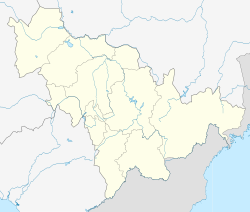
Jilin, is one of the three provinces of Northeast China. Jilin borders North Korea and Russia to the east, Heilongjiang to the north, Liaoning to the south, and Inner Mongolia to the west.

Yanbian is an autonomous prefecture in northeastern Jilin Province, China. Yanbian is bordered to the north by Heilongjiang, on the west by Baishan and Jilin City, on the south by North Hamgyong Province of North Korea, and on the east by Primorsky Krai of Russia. Yanbian is designated as the Korean autonomous prefecture due to the large number of ethnic Koreans living in the region. The prefectural capital is Yanji, and the total area is 42,700 square kilometres (16,500 sq mi).

Dongfeng County is located in southwestern Jilin province, China and is under the administration of Liaoyuan City.
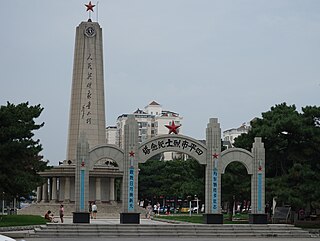
Siping, formerly Ssupingkai, is a prefecture-level city in the west of Jilin province, People's Republic of China. Located in the middle of the Songliao Plain and at the intersection of Jilin, Liaoning and Inner Mongolia, Siping covers an area of 14,323 km2 (5,530 sq mi). At the 2015 census, Siping has a total population of 3.36 million while the urban population is 625 thousand.

Linjiang is a county-level city in southern Jilin province, People's Republic of China, located to the east of Tonghua, and not far from the border with North Korea. It is a county-level city under the administration of Baishan.

Yitong Manchu Autonomous County is located in western Jilin province, People's Republic of China, 52 kilometres (32 mi) south of the provincial capital, Changchun. It comes under the administration of Siping City. More than 38% of the population are ethnic Manchus.

Sunwu County is a county under the administration of Heihe City in the north of Heilongjiang province, China, situated on the bank of Amur River, which demarcates the Sino-Russian border. The length of border line within Sunwu county is 36 km (22 mi).
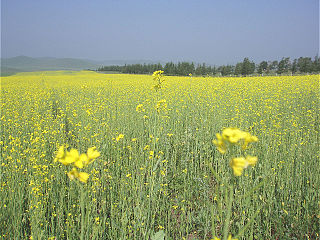
Weichang Manchu and Mongol Autonomous County is a Manchu and Mongol autonomous county located in far northeastern Hebei province, China. It lies under the administration of Chengde City, and is the northernmost county of the province, bordering Inner Mongolia to the north. In terms of area, it is the largest county of Hebei, occupying an area of 9,058 km2 (3,497 sq mi), though, as it is located in mountainous terrain, it is rather sparsely populated, as of 2004, housing 520,000 people.
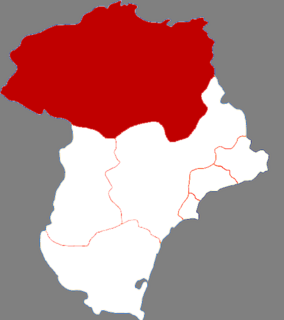
Qinglong Manchu Autonomous County is a Manchu autonomous county of northeastern Hebei province, China, bordering Liaoning to the north and east and located in the eastern part of the Yan Mountains. It is under the administration of the prefecture-level city of Qinhuangdao, and, as of 2004, had a population of 520,000 residing in an area of 3,309 km2 (1,278 sq mi). Bordering county-level divisions are: Lingyuan and Jianchang County (Liaoning) to the north, Liaoning's Suizhong County and Qinhuangdao city proper to the east, Qian'an and Lulong County to the south, and Kuancheng Manchu Autonomous County and Qianxi County to the west.

Jingyu County, formerly Méngjiāng County until February 1946, is a county in southern Jilin province, People's Republic of China. It is under the administration of Baishan City. It is named after General Yang Jingyu, who was killed here during World War II.
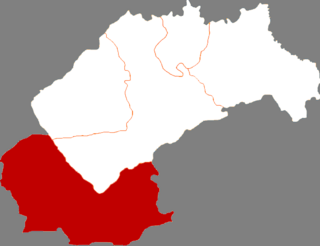
Changling County is a county in the northwest of Jilin province, China, bordering Inner Mongolia to the west. It is the southernmost and westernmost county-level division of the prefecture-level city of Songyuan, with a population of 640,000 residing in an area of 5,787 km2 (2,234 sq mi).

Zhenlai County is a county in northwestern Jilin province, China, occupying the northernmost part of the province and bordering Heilongjiang to the east and Inner Mongolia to the west. It is under the administration of the prefecture-level city of Baicheng, with a population of 310,000 residing in an area of 5,389 km2 (2,081 sq mi).

Wangqing County is a county of southeastern Jilin province, China. It is under the administration of the Yanbian Korean Autonomous Prefecture. The county's name Wangqing comes from the Manchu language meaning fortress.

Xiuyan Manchu Autonomous County is a county in the southeast of Liaoning province, People's Republic of China, and is also one of the 11 Manchu autonomous counties and one of 117 autonomous counties nationally. It is under the administration of and occupies the southernmost portion of Anshan, the centre of which 136 kilometres (85 mi) to the north-northwest, and has a population of 500,000.

Kuandian Manchu Autonomous County, is a county of eastern Liaoning province, People's Republic of China, bordering North Korea to the southeast and Jilin in the northeast. It is under the administration of Dandong City, the centre of which lies 75 kilometres (47 mi) to the southwest, and is served by China National Highway 201. In Kuandian is the Hushan Great Wall, the most easterly section of the Great Wall of China. A short reconstruction of the wall is open to tourists. The area has an abandoned airstrip that was used by the Chinese airforce during the Korean War.

Pingtai is a town of Taobei District, Baicheng, in northwestern Jilin province, People's Republic of China, located more than 20 kilometres (12 mi) west of downtown Baicheng. As of 2011, it has one residential community (社区) and 14 villages under its administration.

Lingxia is a township of Taobei District, Baicheng, in northwestern Jilin province, People's Republic of China, located less than 5 kilometres (3.1 mi) southeast of the border with Inner Mongolia. It is served by China National Highway 302 and G12 Hunchun–Ulanhot Expressway, and as the crow flies, is more than 40 km (25 mi) northwest of downtown Baicheng and 37 km (23 mi) southeast of Ulan Hot, Inner Mongolia. As of 2011, it has 5 residential communities (社区) and 11 villages under its administration.

Dongsheng Township is a township of Taobei District, Baicheng, in northwestern Jilin province, People's Republic of China, located more than 25 kilometres (16 mi) north-northwest of downtown Baicheng. As of 2011, it has 21 villages under its administration.

Dongsheng Township is a township in extreme northwestern Jilin province, China, and it is under the administration of Taonan City. As of 2011, it has 11 villages under its administration. It is about 30 kilometres (19 mi) south-southwest of Ulan Hot, Inner Mongolia, 70 km (43 mi) west-northwest of downtown Baicheng, and 83 km (52 mi) northwest of downtown Taonan.

Sanhe is a town under the administration of Longjing City in southeastern Jilin, People's Republic of China, located along the Sino-Korean border west of North Korea; the nearest major settlement across the Tumen River is Hoeryong in North Hamgyong Province. It is 41 kilometres (25 mi) southeast of downtown Longjing and 50 km (31 mi) south-southeast of Yanji. As of 2011, it has one residential community (社区) and four villages under its administration.


